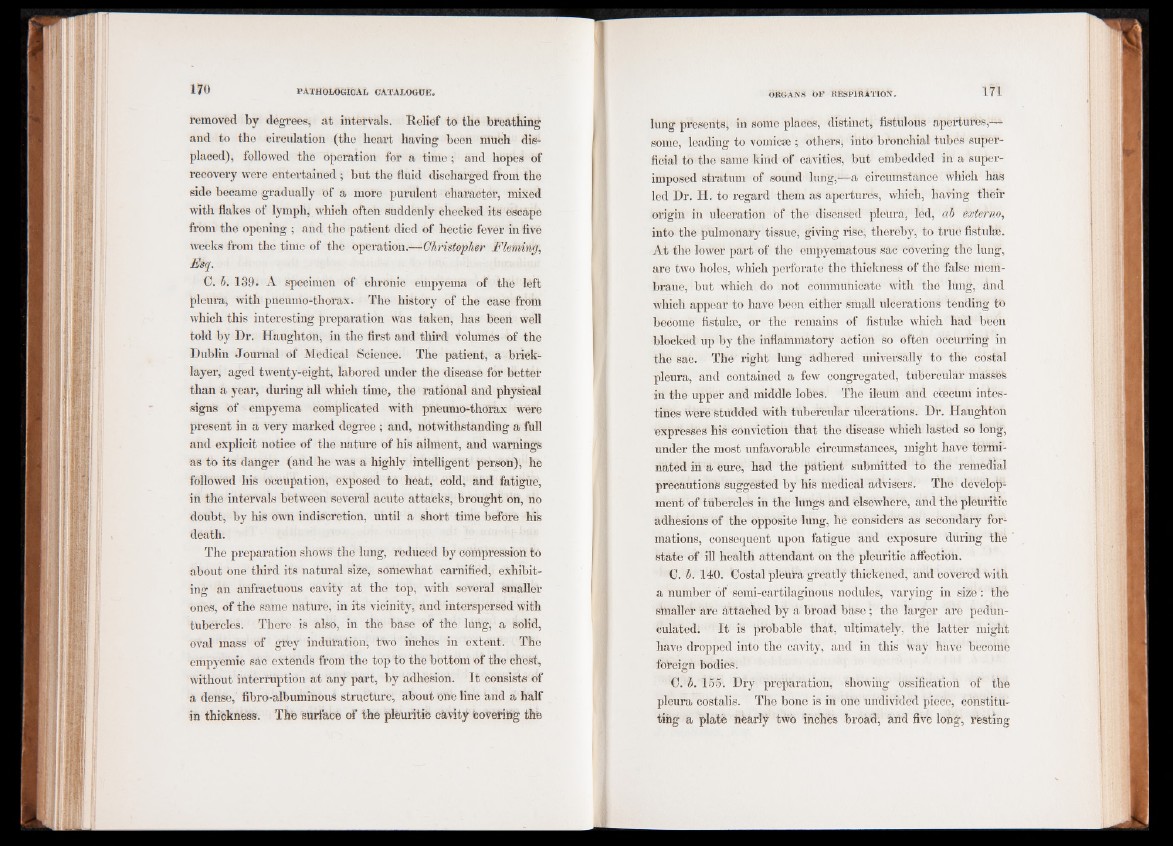
removed by degrees* at intervals. Relief to the breathing
and to the circulation (the heart having been much dis-
placed), followed the operation for a time; and hopes of
recovery were entertained; but the fluid discharged from the
side became gradually of a more purulent character, mixed
with flakes of lymph, which often suddenly checked its escape
from the opening ; and the patient died of hectic fever in five
weeks from the time of the operation.—Christopher Fleming,
Esq.
0. b. 139. A specimen of chronic empyema of the left
pleura, with pneumo-thorax. The history of the case from
which this interesting preparation was taken, has been well
told by Dr. Haughton, in the first and third volumes of the
Dublin Journal of Medical Science. The patient, a bricklayer,
aged twenty-eight, labored under the disease for better
than a year, during all which time, the rational and physical
signs of empyema complicated with pneumo-thorax were
present in a Very marked degree ; and, notwithstanding a full
and explicit notice of the nature of his ailment, and warnings
as to its danger (aiid he was a highly intelligent person), he
followed his occupation, exposed to heat, cold, and fatigue,
in the intervals between several acute attacks, brought on, no
doubt, by his own indiscretion, until a short time before his
death.
The preparation shows the lung, reduced by compression to
about one third its natural size, somewhat carnified, exhibiting
an anfractuous cavity at the top, with several smaller
ones, of the same nature, in its vicinity, and interspersed with
tubercles. There is also, in the base of the lung, a solid,
oval mass of grey induration, two inches in extent. The
empyemic sac extends from the top to the bottom of the chest,
without interruption at any part, by adhesion. It consists of
a dense, fibro-albuminous structure, about one line and a half
in thickness. The surface of the pleuritic cavity Covering the
lung presents, in some places, distinct, fistulous apertures,-—
some, leading to vomicae ; others, into bronchial tubes superficial
to the same kind of cavities, but embedded in a superimposed
stratum of sound lung,—a circumstance which has
led Dr. H. to regard them as apertures, which, having their
origin in ulceration of the diseased pletira, led, ab Memo,
into the pulmonary tissue, giving rise, thereby, to true fistula;.
At the lower part of the einpyematous sac covering the lung,
are two holes, which perforate the thickness of the false membrane,
but which do not communicate with the lung, dnd
which appear to have been either small ulcerations tending to
become fistulse, or the remains of fistula; which had bteen
blocked up by the inflammatory action so often occurring in
the sac. The right lung adhered universally to the costal
pleura, and contained a few congregated, tubercular massCS
in the upper and middle lobes. The ileum and coecUm intestines
Were Studded with tubercular ulcerations. Dr. Haughton
expresses his conviction that the disease which lasted so long,
under the most unfavorable circumstances, might have terminated
in a cure, had the patient submitted to the remedial
precautions suggested by his medical advisers. The development
of tubercles in the lungs and elsewhere, and the pleuritic
adhesions of the opposite lung, he considers as secondary formations,
consequent upon fatigue and exposure during the
state of ill health attendant on the pleuritic affection.
C. b. 140. Costal pleura greatly thickened, and Covered with
a number of semi-cartilaginous nodules, varying in size : the
smaller are attached by a broad base; the larger are pedunculated.
It is probable that, ultimately, the latter might
have dropped into the cavity, and in this way have become
foreign bodies;
C. b. 155. Dry preparation, showing ossification of the
pleura costalis. The bone is in one undivided piece, constituting
a plate nearly two inches broad, and five long, resting